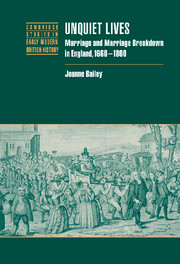Book contents
- Frontmatter
- Contents
- Acknowledgements
- List of abbreviations and conventions
- 1 Introduction: reassessing marriage
- 2 ‘To have and to hold’: analysing married life
- 3 ‘For better, for worse’: resolving marital difficulties
- 4 ‘An honourable estate’: marital roles in the household
- 5 ‘With all my worldly goods I thee endow’: spouses' contributions and possessions within marriage
- 6 ‘Wilt thou obey him, and serve him’: the marital power balance
- 7 ‘Forsaking all other’: marital chastity
- 8 ‘Till death us do part’: life after a failed marriage
- 9 ‘Mutual society, help and comfort’: conclusion
- Appendices
- Bibliography
- Index
- Titles in the series
Appendices
Published online by Cambridge University Press: 27 July 2009
- Frontmatter
- Contents
- Acknowledgements
- List of abbreviations and conventions
- 1 Introduction: reassessing marriage
- 2 ‘To have and to hold’: analysing married life
- 3 ‘For better, for worse’: resolving marital difficulties
- 4 ‘An honourable estate’: marital roles in the household
- 5 ‘With all my worldly goods I thee endow’: spouses' contributions and possessions within marriage
- 6 ‘Wilt thou obey him, and serve him’: the marital power balance
- 7 ‘Forsaking all other’: marital chastity
- 8 ‘Till death us do part’: life after a failed marriage
- 9 ‘Mutual society, help and comfort’: conclusion
- Appendices
- Bibliography
- Index
- Titles in the series
Summary
The data used for this book were entered onto a relational database. The database has two main tables. One (‘Couple’) has biographical information about the married couples, and the other linked table (‘Conflict’) has details about the types of marital difficulties experienced by these couples. As a result, the first table contains 1,403 married couples, and the second 1,583 instances of conflict, because some couples experienced more than one type of difficulty. There are nine additional related tables. ‘Secondary Complaints’ categorises secondary grievances and is linked to the ‘Conflict’ table. The other eight are linked to ‘Couple’: ‘Types of Informal Intervention’, ‘Type of Goods Conveyed’, ‘Sum Bound Over’, ‘Sureties for Wife-Beaters’, ‘Role of Children’, ‘Reason for Adultery’, ‘Context of Adultery’ and ‘Lovers’ Status/Occupation'.
Evidence about other couples' marital difficulties was collected and used in the book, but not entered onto the database because not enough information was available about them or their conflict. For example, accounts and reports of attempted or actual wife/husband murder in newspapers. When these couples are discussed, it is stated in the references that they are not included in the database.
The data was derived from the following sources (see bibliography for information about archives):
ECCLESIASTICAL COURTS
All matrimonial and correction cases from:
Durham: UOD DDR/EJ/CCD/3 (1678 and 1716–1868); UOD DDR/EJ/PRC/2 (1608–1853)
Oxford: Mss.Oxf.dioc.papers c. 91–c. 101
York: CP.H/2446–6009 andCP.I/1–3122 (1663–1800); Cons.CP and Chanc.CP (1800–1990); Trans.CP, indexed in W. J. Shiels, Ecclesiastical Cause Papers at York: Files Transmitted on Appeal 1500–1883, Borthwick Text and Calendar, 9, (1983);
[…]
- Type
- Chapter
- Information
- Unquiet LivesMarriage and Marriage Breakdown in England, 1660–1800, pp. 205 - 222Publisher: Cambridge University PressPrint publication year: 2003

